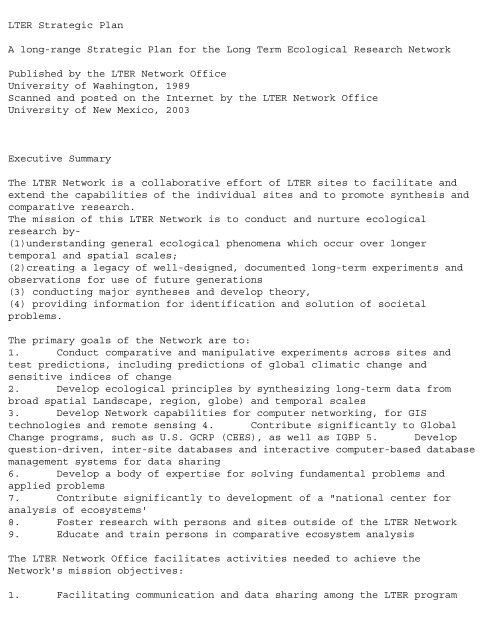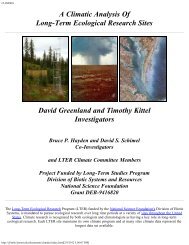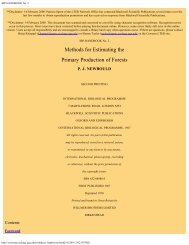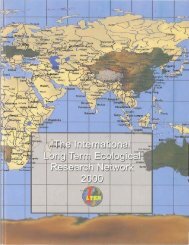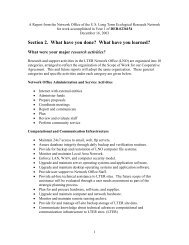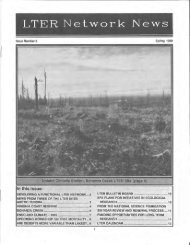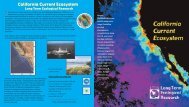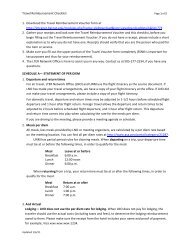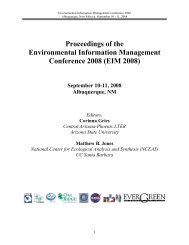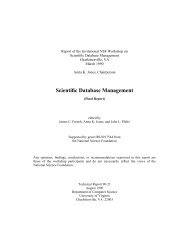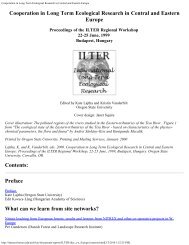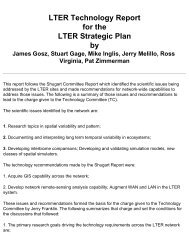LTER Strategic Plan - LTER Intranet - The Long Term Ecological ...
LTER Strategic Plan - LTER Intranet - The Long Term Ecological ...
LTER Strategic Plan - LTER Intranet - The Long Term Ecological ...
You also want an ePaper? Increase the reach of your titles
YUMPU automatically turns print PDFs into web optimized ePapers that Google loves.
4-1.3 Technological needs and opportunities 4.2 <strong>LTER</strong> Network Issues4.2.1 Inter-site experimental science 4.2.2 Synthesis and modeling 4.2.3 Datasharing4.2.4 Standardization in science and in technology 4.2.5 Electroniccommunication and networking4.2.6 Role of the <strong>LTER</strong>/CC, <strong>LTER</strong>/Exec, and <strong>LTER</strong> Network Office4.2.7 Future expansion of the network 4.3 National (U.S.) Issues4.3.1 Links to the larger ecological community, U.S.agencies and science programs and networks 4.3.2 Application of <strong>LTER</strong> researchto societal problems 4.3.3 Education and training4.3.4 Support for a national center for ecologicalresearch, data sharing, and modeling4.4 International Issues4.4.1 Linkages to ecological networks4.4.2 Participation in global research programs5. Implementation of a strategic plan5.1 Selection of goals for 5 years, 1991-19955.2 Development of action plans for each goal 5.2.1 Tasks5.2.2 Responsibilities5.2.3 Resources - financial, personnel, facilities5.3 implementation of action plans5.4 Annual evaluation of progress on action plans 5.5 Final evaluation ofaction plans in 19955.6 Reconsideration of goals and planning for second 5 yearperiod, 1996-20006. Literature Cited7. AppendicesAbbreviations:<strong>LTER</strong>= <strong>Long</strong>-<strong>Term</strong> <strong>Ecological</strong> Research (refers to the NSF-funded 18-sitenetwork; <strong>LTER</strong>/CC LTFER Coordinating Committee; <strong>LTER</strong>/EXEC = <strong>LTER</strong> ExecutiveCommittee;NSF = National Science Foundation; BBS = Biological, Behavioral, and SocialSciences Directorate; BSR = Biotic Systems and Resources Division;NAS National Academy of Sciences; DOI = Department of Interior, USGS = U.S. Geological Survey; USFS US. Forest Service; DOE = Department of Energy,NPS = National Park Service; EPAEnvironmental Protection Agency; CEES = (US.) Committee on Earth andEnvironmental Sciences;<strong>LTER</strong> Sites:ARC, arctic tundra, Alaska; AND, Andrews Experimental Forest, coniferousforest,Oregon; BNZ = Bonanza Creek Experimental Forest, Fairbanks Alaska; CDR, CedarCreek Experimental Area, Minnesota; CPR, Central Plains Experimental Range,Ft. Collins, Colorado; CWT, Coweeta Experimental Forest, North Carolina; HBR,Hubbard Brook Experimental Forest, New Hampshire; HFR, Harvard Forest,Massachusetts; JRN, Jornada Experimental Range, New Mexico; KBS, Kellogg
Biological Station, Michigan; KNZ, Konn Prairie Natural Area, Manhattan,Kansas; LUQ, Luquillo Experimental Forest, Puerto Rico; NIN, North Inlet,North Carolina; NTL, North Temperate Lakes, Wisconsin; NWT, Niwot Ridgealpine, Colorado; PAL, Palmer Station, Antarctica; SEV, SevilletaExperimental Range, New Mexico; VCR, Virginia Coast Reserve, Virginia; NET,<strong>LTER</strong> Network Office, Seattle WA.Summary<strong>The</strong> <strong>LTER</strong> Network is a collaborative effort of <strong>LTER</strong> sites to facilitate andextend the capabilities of the individual sites and to promote synthesis andcomparative research.<strong>The</strong> mission of this <strong>LTER</strong> Network is to conduct and nurture ecologicalresearch by:(1) understanding general ecological phenomena which occur over longertemporal and spatial scales;(2) creating a legacy of well-designed, documented long-term experiments andobservations for use of future generations(3) conducting major synthetic and theoretical efforts;(4) providing information for identification and solution of societalproblems.<strong>The</strong> primary goals of the Network are to:1. Conduct comparative and manipulative experiments across sites andtest predictions, including predictions of global climatic change andsensitive indices of change2. Develop ecological principles by synthesizing long-term data f@ombroad spatial (landscape, region, globe) and temporal scales3. Develop <strong>LTER</strong> Network capabilities for computer networking, for GIStechnologies and remote sensing4. Contribute significantly to Global Change programs, such as U.S. IGBPand CEES, as well as international IGBP5. Develop question-driven, inter-site databases and interactivecomputer-based database management systems for data sharing6. Develop a body of expertise for solving fundamental problems andapplied problems7. Contribute significantly to development of a "national center foranalysis of ecosystems"8. Foster research with persons and sites outside of the <strong>LTER</strong> Network9. Educate and train persons in comparative ecosystem analysis<strong>The</strong> <strong>LTER</strong> Network Office facilitates activities needed to achieve theNetwork's mission objectives:1. Facilitating communication and data sharing among the <strong>LTER</strong> programand other sicentific communities;2. Supporting the planning and conduct of collaborative research efforts
including provision of some technical support services;3. Leading intersite scientific activities; and4. Providing a focal point and "collective- representation of the <strong>LTER</strong>Network in its external relationships.In furthering these goals, a number of tasks or action items have beendeveloped, primarily by the LTF-R/CC at the October 1989 <strong>Strategic</strong> <strong>Plan</strong>ningsession:1 Sites need to identify what data and core data sets are available, and todocument these.2 Standardization is useful, particularly for synthetic multi-site projects,and for multi-site experiments, and for exchange of data.3 Workshops dealing with each of the 5 Core Areas would be very useful indeveloping broad ecological principles, as well as in designing new projectsand experiments at larger time and space scales.4. Continuity of <strong>LTER</strong> sites can be nurtured by encouragement of 'groupleadership", development of a critical mass of scientists, both within thesite and outside the site, activities like the AU Scientists' Meeting,and byrotating representation at <strong>LTER</strong>/CC meetings.5. Network activities are a collective effort to expand the scientific andeducational capabilities of individual sites, particularly in comparativeanalysis and synthesis.6. <strong>The</strong> <strong>LTER</strong> Network should expand to about 20 sites to include other diverseecosystems. Linkages to other ecological networks and sites is also a highpriority.(summary statement)I. Introduction1.1 Background<strong>The</strong> <strong>Long</strong>-<strong>Term</strong> <strong>Ecological</strong> Research program, consists of 18 site-based projectsindividually funded by the National Science Foundation (Table 1). Moredetailed information on the sites and programs can be found in Appendix I.<strong>The</strong> individual <strong>LTER</strong> projects decided to formalize a network-levelorganization very early in the program in order to facilitate the developmentof multi-site long-term research. <strong>The</strong> governing body for this network iscurrently the <strong>LTER</strong> Coordinating Committee (<strong>LTER</strong>C/C) which consists of onerepresentative from each site and a chairman. J.F. Franklin has chaired <strong>LTER</strong>/CC since 1983.Development of the network-level program in <strong>LTER</strong> has been a gradual and
sometimes difficult process. For reviews, see Callahan (1984), Swanson andFranklin (1988) and Franklin et. al. (1990). To briefly summarize, activitiesbegan in discussions at NSF in the BSR Division among Dr. John Brooks andvarious scientists, both within NSF and outside. In 1977, a series of threeworkshops considered the content and structure of a program of long-termecological research (NSF 1977, 1978). <strong>The</strong>se efforts became the basis for thefirst <strong>LTER</strong> "Request for Proposals" in 1980. Five Core Areas of Research wereidentified and became a major programatic commonality among all sites.Since 1980, a total of 20 research projects have been funded as a result of 5separate NSF competitions, the most recent in 1990. Special panels werecreated for peer review of each set of proposals. Site selection was based onquality of the science represented by the proposals, not upon their potentialplace within the larger network. Awards have usually been for 5-year periods,after which, sites are required to submit new proposals. Two projects wereoriginally funded and then not renewed at the reevaluation point by NSF.1.2 Mission<strong>The</strong> mission of the <strong>LTER</strong> Network, as defined in its strategic planningexercise, is to conduct and nurture ecological research by:-identifying and understanding general ecological phenomenawhich occur over longer temporal (e.g., decadal) and spatial (e.g., regionaland global) scales;-creating a legacy of long-term experiments andobservations, soundly designed and adequately documented, for the use offuture generations of scientists;-advancing ecological science by conducting major syntheticand theoretical efforts, especially those differing in perspective and scopefrom those developed by individual site programs; and-providing information for identification and solution of societal problems.<strong>The</strong> Network is identified as a collaborative effort of these sites tofacilitate and extend the capabilities of the individual sites and to promotesynthesis and comparative research.1.3 Vision of <strong>LTER</strong>'s FutureAt two <strong>LTER</strong>/CC meetings (April 1989 and October 1989), the group discussedwhat their vision of <strong>LTER</strong> was. Dr. Jack Hautaluonia, a management consultantfrom Colorado State University, assisted the group both times.A summary of these discussions is the following:Locally, <strong>LTER</strong> programs would conduct site-specific science (long-term andwide-area) which would recognize important, new factors affirming theenvironment, develop findings to problems of sustainability of naturalresources.Nationally, <strong>LTER</strong> would interact with the entire ecological community, helpingto solve global problems. Further, <strong>LTER</strong> would be a national resource for thescientific community, integrating long-term ecological research with naturalresource management. <strong>The</strong> <strong>LTER</strong> Network would be organized around scientific
issues, supplying leadership and models to the ecological community.Internationally, <strong>LTER</strong>would become denser", with sub-sites, and withconnections to an international network, working to solve global problems.In several of the discussions, participants were asked to draw their "vision"of the <strong>LTER</strong> Network- Three of these are shown below:1.4 Legacies of <strong>LTER</strong><strong>The</strong> following Comments about <strong>LTER</strong> legacies was taken froma small group discussion at the October 1989 <strong>LTER</strong>/CC meeting on <strong>Strategic</strong>planning. <strong>The</strong> group included (Vande Castle, chair, NET; Viereck (BNZ), Foster(BFR), Robertson (KBS), Webber (KBS), Brown (SEV), and Brooks (invitedparticipant, former NSF/BSR Division Director). <strong>The</strong> group asked themselves,Is creation of a legacy of long-term observations and experiments animportant function of <strong>LTER</strong>? If so, how well are we doing it?<strong>The</strong> importance of a legacy is that the observations and experiments transcendthose from individual sites. Continuing experiments/long-term experimentsform the basis of this legacy. <strong>The</strong>Network is the link to long-term global issues. Sites already have a legacyfrom the data which they have already coffected/archived as well as thehistorical data most sites have (weather data as an example). It is importantto consider that data and design may be applicable to research to which itwas not originally intended, just as data are even now being applied.Documentation is needed as to the methods and the data (an audit trail needsto be preserved).<strong>The</strong> group also considered nhow good a legacy" <strong>LTER</strong> is currently creating.<strong>The</strong>y suggested that LTFER is not always doing well due to documentation,gaps, techniques, and data forms. 7le <strong>LTER</strong>Network should take advantage of what has already been done by having andmaintaining a backbone of data. Within sites, <strong>LTER</strong> is doing better thanbetween/among sites or the network itself. <strong>LTER</strong> needs to ident what data wehave (e.g. lists of data available at all sites and CORE data sets). <strong>The</strong>Network needs to impose some standards/methods. It would be good to use pastdata with feedback with workshops, etc. Across sites, it is more difficult tocreate legacies of long-term data and experiments; standardization isimportant.ACTION ITEMS1. Initiate workshops which deal with the '5 Core Areas', perhaps beginningwith Core Area #1, primary productivity2. comparability of site's data3. emerging/EXCITING research possibilities
2. LOng-<strong>Term</strong> Goals and ObjectivesIn a series of discussions at <strong>LTER</strong>/Cc meetings, the group listed, modifiedand prioritized their goals for <strong>LTER</strong>-both Research Goals and OperationalGoals. qle top ten goals in each category are listed in order of priority, #1being most important.RES ARCH GOALS:I Conduct parallel manipulative experiments across sites and testpredictions2 Conduct comparative studies to test ecological theories in a broadarray of ecosystems3 Predict effects of climate change on ecosystems and test predictions4 Synthesize long-term landscape-level ecological principles acrosssites 5 Develop predictions across scales, from small to global6 Determine sensitivity indices for directions of ecosystem change7 Compare ecosystem processes that buffer change8 Extrapolate <strong>LTER</strong> results to a broader geographic region9 Conduct comparative analyses with remotely sensed data10 Incorporate studies of biodiversity into <strong>LTER</strong> researchOPERATIONAL NETWORK GOALS:I Develop network capabilities (LAN, WAN)2 Develop GIS capabilities3 Develop <strong>LTER</strong> as a leader in U.S. IGBP4 Develop question-driven inter-site databases5 Transfer information from basic research to applied problems6 Develop interactive computer-based database management systems 7Develop a body of expertise for solving fundamental problems8 Develop <strong>LTER</strong> as a leader in creating a 'center for analysis ofecosystems'9 Foster research with persons and sites outside of the <strong>LTER</strong> Network10 Educate and train persons, particularly women and minorities, incomparative ecosystem analysis 93. Historical and Current Context for <strong>LTER</strong><strong>The</strong> National Science Foundation has begun a major biological activity, fundedat about $7 million dollars per year. This activity, called the <strong>Long</strong>-<strong>Term</strong><strong>Ecological</strong> Research (<strong>LTER</strong>) activity, is a large-scale coordinated researcheffort supported by NSFs Division of Biotic Systems and Resources (BSR). Thisexciting experiment is the first sustained, long-term and large-scale projectin biology funded by NSF.
From 1967 to 1979, the basis for <strong>LTER</strong> developed from a series of 3 workshopsinvolving many members of the scientific community (Callahan 1984). Inrecognition of the advantages of long-term research programs and thehistorical difficulty of sustaining such research efforts, the NSF instituted<strong>LTER</strong> in 1980 [Callahan, 19841 with funding of six sites, a number that hasnow grown to 18. <strong>The</strong> existing sites span a great array of terrestrial andaquatic ecosystems - desert, prairie, tundra, forest, small stream, bigriver, lakes, and estuaries.<strong>The</strong>re are at least three major strengths of this <strong>LTER</strong>activity. One majorstrength is the developing network, which allows comparative experiments tobe made. <strong>The</strong> network can evaluate intensive investigations at single siteswithin the context of larger scales. Data management can be coordinated,providing convenient, accessible databases for development of theories,testing of hypotheses and building of models. This accumulation ofinformation at many levels of organization and spatial and temporal scales isan extremely valuable resource. This resource can study phenomena at higheror lower organizational levels, which may have in the past been treated asinsignificant.A second major strength is the long-term nature of the research. <strong>Ecological</strong>phenomena occur over decades, centuries and longer, yet these time periodsare beyond the scope of most short-term (2-5 year) NSF awards. Sufficientknowledge of year-to-year variability is needed to interpret trends,particularly in non-equilibrium biological systems. Trends can be evaluated,separating unidirectional changes from cyclic changes or backgroundvariability.A third major strength is the preservation of natural ecosystems for study bypresent and future generations of scientists. Examples of plant, animal,soil, water, and other components can be archived, analyzed and used forfuture comparisons. Biodiversity can be preserved. <strong>Long</strong>-term studies ofchange, such as global climate change, can be initiated.<strong>The</strong>re are common threads that tie these diverse <strong>LTER</strong> sites together andfacilitate collaborative research. <strong>The</strong>se threads include: (a) establishedresearch sites with long-term records of environmental and biologicalvariables; (b)assurance of continued security and availability of researchsites; (c) areas of relatively pristine, preserved ecosystems, as well asareas where large-scale manipulative experimentation is possible; (d)established interdisciplinary teams of researchers with stable leadership andinstitutional support; (e) programs of research in five core areas (describedbelow), and (o a commitment to work with other sites in the <strong>LTER</strong> network.<strong>LTER</strong> involves groups of investigators working at representative sites locatedin diverse biogeographic regions. Investigators focus on a series of 5 coreresearch topics, coordinate their studies across sites, utilize documentedand comparable methods, and are committed to long-term research.<strong>The</strong> core research areas are:(1) pattern and control of primary production:(2) spatial and temporal distribution of populations selected to represent
trophic structure: (3) pattern and control of organic matter accumulation insurface layers and sediments:(4) pattern of inorganic inputs and movements of nutrients through soils,groundwater, andsurface waters; and(5) pattern and frequency of disturbance to the research site.<strong>The</strong>re are currently (September 1990) 18 sites in the <strong>LTER</strong> network; thesesites are located inAntarctica, and in the United States in 13 states, and in the territory ofPuerto Rico:ALASKABonanza Creek (BNZ), Arctic Lakes (ARC)COLORADONiwot Ridge (NWT), Central Plains (CPR)KANSASKonza Prairie (KNZ)MASSACHUSETI'S Harvard Forest (BFR)MICHIGANKellogg Biological Station (KBS)MINNESOTA Cedar Creek Experimental Area (CDR)NEW HAMPSHIRE Hubbard Brook Experimental Forest (HER)NEW MEXICO Jornada Desert (JRN), Sevilleta Range (SEV)NORTH CAROLINA Coweeta Hydrologic Lab (CWT)OREGONAndrews Experimental Forest (AND)SOUTH CAROLINA North Inlet (NIN)VIRGINIAVirginia Coast Reserve (VCR)WISCONSIN North Temperate Lakes (NTL)PUERTO RICO Luquillo Experimental Forest (LUQ)ANTARCTICA Palmer Staton (PAL)3.3.<strong>The</strong>se sites are generally associated with one or more academic institutionsand a variety of government and private agencies, as illustrated in thefollowing table, which summarizes the major supporters of <strong>LTER</strong> activities ateach site.Site Primary Institution Other supporting groupsAND Oregon State Univ USFIS \ARCMarine Biol LabBNZ Univ Alaska USFS CDR Univ MinnCPR Colo State Univ USDACWT Univ Georgia USFS (SE region)HBR Cornell Univ Syracuse U., Carey Arb.,USFS,HFR Harvard Univ Marine Biol LabJRNN Mexico State Univ San Diego State U., Duke UKBSMichigan State Univ Kellogg FoundationKNZ Kansas State Univ Nature ConservancyLUQ Univ Puerto Rico USFSNIN Univ S Carolina Baruch InstituteNTLUniv WisconsinNWT Univ Colorado USGS
PAL U.CA Santa Barbara Old Dominion Univ, VA; Pt.Reyes Bird Observatory, CASEV Univ N Mexico US Fish & WildlifeVCRUniv VA Charlottes- Nature Conservancy ville VA<strong>LTER</strong> sites are selected on the basis of peer evaluation of proposalssubmitted to the NSF. After site selection, sites carry out substantiveresearch programs at each individual site. <strong>The</strong> substantial effort that goesinto intersite activities is led by a coordinating committee (<strong>LTER</strong>/CC)consisting of one representative from each site.<strong>The</strong> 17 <strong>LTER</strong> sites are loosely collected into an integrated group, organizedfor the purposes of conducting similar experiments across sites, carrying outcollaborative research, fostering comparative studies and serving as a modelfor large-scale, long-term research in ecology. This integrated group iscalled a 'network.' <strong>The</strong>re is a centralized network office, located at theUniversity of Washington inSeattle WA, where the chair of the <strong>LTER</strong>/CC, Dr. Jerry Franklin, is located.<strong>The</strong> Coordinating Committee (<strong>LTER</strong>/CC) has as many members as there are sitesin the Network. <strong>The</strong>se representatives are selected by the individual sites,the procedure being decided by the sites. <strong>The</strong> representatives elect a chair,either from their group or someone associated with a site. <strong>The</strong>re have been 2chairs of this group - Dr. Marzoff from Konza <strong>LTER</strong> (1981- ) and Dr. JerryFranklin (Andrews <strong>LTER</strong>,198- - present). <strong>The</strong> length of the term of the chair is at the discretion ofthe <strong>LTER</strong>/CC. <strong>The</strong> <strong>LTER</strong>/CC meets regularly, generally twice a year - spring andfall. Meetings are usually at one of the sites.3.2LTFER <strong>Strategic</strong> <strong>Plan</strong>4. Critical Issues 4.1 Site-based Issues4.1.1 Research programsResearch programs at the sites are a combination of site-initiated researchand 'core-area research". <strong>The</strong> success of <strong>LTER</strong>depends upon the interest,creativity and productivity of individual scientists, working alone andworldng together within their site and working together with other sites inthe network. This success depends on finding creative ways to support bothsite-initiated research and networked-research.4.1.2 OrganizationAt the Fall 1989 <strong>LTER</strong>/CC meeting on <strong>Strategic</strong> <strong>Plan</strong>ning, a number of topicswere discussed, including aspects of organization and continuity of sites.7le following discussion originated from working group #6.How to Nurture Continuity within Network? Group 6 also considered how <strong>LTER</strong>cannurture continuity in leadership, given the hightly individualistic nature ofedsting programs. <strong>The</strong>ir suggestions are:(a) It is important to distinguish that of the sites from that of thenetwork
(b) Insure critical mass of people senior personnel rather than just Idistinguished P.L(c) It is possible to recruit the critical mass of people for a sitefrom other sites (although this doesn't guarantee it)(d) to some extent this requires some degree of altruism from within(e) provide the excitement of the collective enterprise(f) provide support of 'troubled' sites (leadership, move of P.1 etc.)to preserve the legacy(g) it is not outside the possibility of a site being takenover if this is what is needed to be sustained(h) executive group with revolving members provides changing/widerview (i) Leadership should be not only be from exec or abovej) most adequate mechanisms are already in place(k) AU scientists meeting is important, including interaction,and teleconferencing(l) the network should encourage interaction(m) there is a need to put <strong>LTER</strong> science to the outside by means ofpublications and special symposia at meeting such as ESA4.1.3 Technological needs and opportunities. Two important meetings were heldto discuss technological needs and opportunities. Reports from these meetingsare informally referred to as the "Shugart' report and the 'Gosz' report (seeAppendix). <strong>The</strong> Shugart report (Januaxy 1988 meeting, Washington DC)recommended that the <strong>LTER</strong> Network acquire technological capabilities in GIS,remote sensing, database management and electronic network connectivity. neGosz report (January 1989 meeting, Washington DC) built on the Shugart reportand examined other technologies and their importance to long-term, broadscaleecological research. This Gosz report emphasized the criticalimportance of acquisition of remote images for all sites as soon as possible,with secondary emphasis on .........Following the Gosz report, <strong>LTER</strong> sponsored a two-day workshop on remotesensing was held at the university of New Hampshire to determine the role ofremote sensing for the <strong>LTER</strong> Network, stimulate cross-site research projectsand build a network of scientists interested in remote sensing within <strong>LTER</strong>.<strong>The</strong> research focus of the meeting centered on the need for vegetation indicesanalysis, the integration ofremote sensing into ecological analysis andmodeling, and the need and support for high resolution remote sensing systemssuch as those planned under NASAs Earth Observing System (EOS) program. <strong>The</strong>plan for initial remote sensing data acquisition for the LT'ER Network wasformulated for a recently funded proposal submitted by the NETWORK Office asa result of this workshop.A GIS workshop held in September 1989was held at Colorado State University,and hosted by the Central Plains Experimental Range (CPR) <strong>LTER</strong> site. <strong>The</strong> ninedaytraining session provided lessons and training in ARC/INFO and ERDAS,which are part of the Minimum Standard Installation for each site.<strong>The</strong> workshop was designed to enhance the investment in GIS tools for analysisand modeling as well as the integration of remote sensing technology into
ecological research of Network. <strong>The</strong> workshop report is included in theAppendix.4.2 <strong>LTER</strong> Network Issues4.2.1 Inter-site experimental science.At the October 1989 <strong>LTER</strong>/CC meeting on <strong>Strategic</strong> <strong>Plan</strong>ning, Group 4 discussedthis topic.Members included: Melillo (FIFR), chair, Hobbie (ARC), Meyer (CWT),Cunningham (JRN), Bowser (NTL), Funk (affiliation ?), Schindler (NSF). <strong>The</strong>group emphasized this concept:Scientists are the source of questions and the network should facilitatetheir development.<strong>The</strong> group discussed a series of 3 questions, then developed 9 specific ActionItems.Question l. How do we identify the scientific issues to be addressed?Questions should be those that require a network of sites to be answeredrather than questions that can be answered at individual sites. This does notmean that all questions must be addressed at all sites. Questions shouldideally relate to long-term phenomena, although (especially initially) shorttermquestions are also of interest. A series of criteria that are notnecessary met by all proposals1) Important question at a large scale2) Important social issueQuestion 2.How does the network facilitate this? A continuum of approacheswith workshops at one extreme and an individual pursuing a question ofinterest at the other. Coordinating committee funds workshop with input fromPls on what should be funded. Non <strong>LTER</strong> scientists welcome to participate.Requires rapidly circulated report--perhaps the newsletterQuestion 3. How do we promote use of site resources? Continue to developminimum standard technologies, an inventory of data, a resource inventory(what long-term experiments are being done at the sites) , encourageacquisition of technologies that can be shared (e.g., shared technologicaltools - global positioning modules, etc.).ACTION ITEMS1. Continued support of workshops designed to addressmultiple-site research questions.2. Devote a section of <strong>LTER</strong> newsletter to reporting aboveworkshop results3. Make database catalogs and publication list a highpriority
4. Develop annotated list of ongoing long-term experiments5. Develop and support shared technologies, such ascentralized facilities, and portable measuring equipment6. Establish intersite training paradigm--ongoing, e.g.,modeling and trace gas measurements7. Promote efforts of wider ecological community toestablish center for synthesis8. Establish a small number of FLAGSHT experiments9. Continue to act on the MSI or "minimum standard installation" conceptfor development of technological items (computer communications,datamanagement, GIS, remote sensing, etc.)Further Developments after October 1989 <strong>LTER</strong>/CC Meeting. A number of theaction items have been initiated. A large number of research projectsinvolving multi-site comparative analyses have been undertaken and completedby the <strong>LTER</strong> Network. AU have involved development and analysis of pooleddatabases and several have developed into major syntheses. <strong>The</strong> <strong>LTER</strong>Newsletter reports on workshop activities (Action Item 2). <strong>The</strong> <strong>LTER</strong> DataManagers have compiled a Core Dataset Directory, with publication anticipatedin Fall 1990 (Al 3). 'Be <strong>LTER</strong> Network will acquire both remote sensed datafor all sites and has purchased shared GPM (global positioning module)equipment (Al 5). At the AllScientists Meeting, an inter-site (both <strong>LTER</strong> and other sites) researchproject for a large ('Flagship') experiment on soil warming was developed (Al8).4.2.2 Synthesis and modeling (to be written)4.2.3 Data Management and Data Sharing.Report from the <strong>LTER</strong>LCC Meeting, Oct )ber 1989At the <strong>LTER</strong>/CC meeting on <strong>Strategic</strong> <strong>Plan</strong>ning, the Data Management workinggroup included Van Cleve (BNZ), chair; Swank (CWT), Whitford (JRN), Dueser(VCR), Gosz (SEV), Edwards (NSF), and Stafford (AND and chair LT'F-R DataManagers Committee). <strong>The</strong> group discussed the followingtopics:Kinds of Information. What kinds of data - site characterization, baselinedata, weather, question- driven, core area data.Availability of Data. Availability would be at the discretion of theinvestigators, with the ultimate goal of making information accessible to thegeneral scientific community. <strong>LTER</strong> is committed tocommon data sharing with appropriate safegards. At present, it is notfeasible to have all databases on- line, but databases can be exchangedwithout on-line capabilities (e-mail, hard copy, disk exchange, tapeexchange, etc.).Larger pooled databases will be created in response to inter-site, questiondrivenactivities. Centralized dtatbases are not necessary within a fully
functioning network. We propose a flexibleapproach to maintenance of pooled databases, which are at the discretion ofthe individual investigator, but with the eventual objective of inclusionwithin a network archivesLeadership in Data Management Research. <strong>LTER</strong> can become a leader ininformationmanagement as a result of the unique nature of long-term ecological data.Research on information management within the <strong>LTER</strong> Network will result inmore timely, efficient, interactive processing,interpretation and publication. <strong>Long</strong>-term archiving will be assured by thisapproach.Protocols. Protocols for information use and exchange are essential,especially for: (a) data collection (b) storage(c) access and retrival(d) acknowledgement of shared data (e) documentation(o quality assuranceDiscussion of Data Sharini!Data Sharing, a complex issue, includes these topics:1 sharing selected data sets2 development of "meta-datan databases3 development of specific inter-site databases for use in solvingspecific scientific questions (e.g. the 'decomposition' and 'variability"databases)4 development of protocols for storing and retrieving datasets5 compatibility and access among different site databasemanagement systems (DBMS)6 discussion of the desirability or undesirability to select acommon DBMS.In discussing these topics, a major contribution has been made by the <strong>LTER</strong>Data Management Committee (see list of committees in the Appendix). <strong>The</strong>following text includes materials developed by this committee, as well asinformation from <strong>LTER</strong>/CC meetings and workshops. Although 6 topics arelisted, consensus has not been reached on several topics, and only topics 1and 2 are discussed here. Further work is needed on the remaining 4 topics.<strong>The</strong> <strong>LTER</strong> Network's substantial advances in data management includedevelopment of protocols for data documentation and archiving and the MSI.<strong>The</strong>se have substantially improved the Network's ability to exchange and pooldata-Signficant steps in developing on-line, data bases have also been taken.Several pooled data bases now exist as a result of Network-sponsoredworkshops and individual research projects.4.2-3.1 Sharing selected data sets. Perhaps the first <strong>LTER</strong> inter-sitedatabase was developed in conjunction with the Variability Workshop at NTL,Dr. John Magnuson as leader. This workshop is summarized below.Sharing of <strong>LTER</strong> data among <strong>LTER</strong> sites was essential to the intersitevariability project which examined and compared the temporal and spatial
variability of 11 of the <strong>LTER</strong> sites. This constiuted one of the very firstefforts in the network to jointly provide and analyze original data collectedby the sites.<strong>The</strong> procedure involved Magnuson visiting almost all of the participatingsites to explain the project. <strong>The</strong>n each site sent the appropriate data to Dr.Tim Kratz, also from the NTL site, who prepared a data base which is nowpublic and on file electronically at the network office. Three intersitepapers are in progress (two in press, one in manuscript). Each participant atthe analysis workshop held at the north temperate lake site at Trout Lake isan author on at at least one of the papers. To further ease this early effortindata sharing, the public data base only includes derived variabilityestimates of measurements at the sites,rather than the original site data.(insert statement describing the access policy adopted at the workshop)4.2.3.2 Development of "meta data databases". 71c <strong>LTER</strong> Data Managersdeveloped the following statement at their annual August 1990 meeting.(DRAFT - Contents under Revision)Minimum Set of Meta-Data (Documentation) for all Data Abstracts of <strong>LTER</strong> DataSets.Meta-data is that data needed to access, retrieve, and interpret scientificdata. After some review of how the various sites organized and maintainedtheir meta-data, the discussion shifted to the role of the data manager inacquiring this documentation. Based on comments from the <strong>LTER</strong> Data Managers,one major problem is receiving necessary data abstract information which onlythe principal investigator can provide. A considerable quantity ofinformation may need to accompany a given data set, but certain keyinformation must be available before a data set can be properly installed foraccess in a long-termdatabase.Ideally, this information should be provided in the early planning process ofa study.Unfortunately, investigators sometimes forget that including the Data Managerin planning discussions will improve data collection and processing.Furthermore, we are not suggesting that PI(s) involvement with data setdocumentation should end here, rather we recommend that the PI and DataManager establish a long-term symbiotic relationship. From the Data Manager'sperspective, it would be ideal if the principal investigators viewedinstalling data in a long-term database as highly desirable, and viewedcooperation with the site data manager on data documentation as critical tolong-term database value.We are proposing the following minimum set of standard information for dataabstracts which the PI(s) must provide:
Study title:<strong>The</strong> title of the study.Keywords:Keywords that will aid other researchers inreview and retrieval of studydata (a prototype list is available in the <strong>LTER</strong> Core Data Set Catalog forreview by the PI(s) if necessary).Parameters:<strong>The</strong> primary variables that occur in the study.Site location:<strong>The</strong> specified study site location(s).Purpose,goals:A statement of the objectives and goals of thestudy as they relate to study data sets.Exp'tl design:An outline of the experimental or sampling designof the study in sufficient detail to describe the basic experimental orsampling approach, plot size and shape, experimental unit(s), sampling unit(s), timing of sample, etc.Methods:A description of the method by whichmeasurements were taken (bothfield and laboratory) with adequate detail provided to judge the propriety ofpotential comparison of data sets with regard to methodology.Proprietary limits: Specify access restrictions and an expected datewhen data become public property-<strong>The</strong> above informational categories can initially be easily ignored by a datamanager, as data set formatting and error checking are more immediate tasks.However, this documentation is essential in maintaining data set integrity;data managers must be vigilant in securing this information, and thiscommitment must be supported by the Pf's.4.2.4 Standardization in science and in technology. At the October <strong>LTER</strong>/CCmeeting on <strong>Strategic</strong> <strong>Plan</strong>ning, Group 2 discussed standardization. Membersincluded Blood (NIN), Caine (NWT), Knapp (KNZ), Lattin (AND), Lauenroth(CPR), Rodman (NSF), and Yavitt (FMR). <strong>The</strong> group worked with an underlyingpremm that standards are useful. <strong>The</strong>y discussed levels of standardization,from the "5 core research areas' at the sites, to network-wide standards forexperiments (similar to NADP (National Acid Deposition Program)), toregional, national and global standards for research, communication anddata exchange.<strong>The</strong> group agreed that standards are not required for hardware, but may beuseful; rapid information exchange over a network communication system wouldbe very useful. Information exchange will also facilitate the development ofcommon measurements when desirable. For common experiments, a hi.ah level ofstandardization is needed. <strong>The</strong> group supported the efforts of the <strong>LTER</strong> DataManagers Committee to develop standard criteria for data management, althoughthe "methods themselves do not have to be standardized. <strong>The</strong> group recommended
3 action items:ACTION ITEM #1: Certain parameters should be measured and data collectedacross all sites. Examples include remotely-sensed images, GIS data, maps ofsites with geopositioning modules, etc. <strong>LTER</strong> shouldnot 'set standards" for other sites or programs, but could be an example andcould create opportunities for information exchange with others.ON I hM #2: <strong>LTER</strong> Network should develop a bulletin board or 'clearing house'for exchange of information about hardware, software, methods,datamanagement, etc.ACMON ITEM #3: <strong>LTER</strong> should periodically review <strong>The</strong>thodsn and look foropportunities to standardize. One possible area for review might be the nScore areas of research'.Further Developments. Since the October 1989 meeting, <strong>LTER</strong> scientists anddata managers have continued to develop standardization in some areas ofscience, particularly areas in which inter-site comparisons are important. Itis recognized that any discussion must be an an ongoing discussion, asgoals, technologies and scientific objectives change. <strong>The</strong> followingparagraphs describe 5 areas in which standards have been or are currentlybeing implemented, and suggest future areas for discussion:I the "MSI" concept2 the "Connectivity" concept,3 GIS and remote sensing standards 4 the 'core data set' concept5 standard protocols for common inter-site experiments<strong>The</strong> MSI Concept. <strong>The</strong> <strong>LTER</strong> Network has developed, adopted, and implemented aset of standards for the types of equipment and software necessary to forcommunication and exchange of data--the MINUMIUM STANDARD INSTALLATION (MSLsee Appendix). <strong>The</strong>se technologies include 3 areas: (a) LAN and WAN hardwareand software; (b) GIS systems; and (c) high-capacity data storage system.Briefly, all 17 <strong>LTER</strong> sites and the Network Office have (or are) acquiredcomputer equipment to link scientists in an electronic network (see theConnectivity Report, Appendix).Sites have also purchased GIS systems (often SUN computer work stations) andGIS software (often ARC/Info and ERDAS). Standards for parameterization of<strong>LTER</strong> Network Oceanographic Information Systems (GIS) are under preparation.<strong>The</strong> <strong>LTER</strong> Network is also continuing to develop additional standards forselection and measurement of parameters as has already been doneforclimatological and some ecological processes, such as tree populationstudies. Many sites have optical disk drives for data storage. Most sites areacquiring the expanded standardized needed for processing remote imagery. <strong>The</strong>images themselves (AVHRR, SPOT, HAP, etc.) will be purchased by the NetworkOffice with a group license, allowing access to all images by scientistswithin the network<strong>The</strong> 'Connectivity" Concept. In the summer and fall of 1989, NSF asked the<strong>LTER</strong> Network to evaluate the status of electronic connectivity within thenetwork. Dr. Franklin, chair of LTF-R/CC, appointed 3 members - James Brunt(SEV), chair; John Porter (VCR), and Rudolf Nottrott (NF,-f), <strong>LTER</strong> DataManager. This 'Connectivity Team' collected information from all sites
(questionaires, phone calls, etc.) and visited 5 sites (CWT, NIN, HFR, HBR,ARC). <strong>The</strong>ir report (see Appendix) made specific recommendations for enhancingthe connectivity of the <strong>LTER</strong> sites (both main univerisity-based site andfield stations). After a proposal was funded by NSF in the fan 1990, theNetwork Office has begun to implement some of these recommendations.GIS/Remote Sensing. In the Fall 1990, the Network Office was funded toacquire various remotely-sensed data for all sites in the Network (AVHRR,SPOT, HAP, etc.)(see Appendix,"Connectivity/Remote Sensing Proposal'). At the September 1990 AU ScientistsMeeting, several working groups discussed development of standards, commonprotocols and inter-site research, using GIS and remote sensed data. <strong>The</strong>reports from these groups are pending.<strong>The</strong> Core Data Set Concept. <strong>The</strong>re is an <strong>LTER</strong>NETWORK CATALOG OF CORE DATASETS as a first step ingeneratinga searchable on-line data base. This catalogidentifies core data sets from all of the <strong>LTER</strong>sites, includingmany of theolder sets that have not been readily accessible to all interestedscientists,both inside andoutside <strong>LTER</strong>. <strong>The</strong> catalog includes investigator, subjectkeyword, site, and core area indices and has beenproduced in both electronicand printed form.In addition to assembly of this catalog, there is interest in the Network ina re-evaluation of this concept, and discussion of how more comparable datamight be collected. This discussion will continue at the Spring 1991 <strong>LTER</strong>/CCmeeting.Standard Protocols for Inter-Site Baeriments. <strong>The</strong> first major intersiteexperiment was proposed by John Magnuson (NTL), for a comparison ofvariability (in numerous parameters) across a number of sites within theNetwork- Magnuson contacted sites and 12 joined the experiment by supplyingdata from which various variability parameters were calculated. A workshopwas held at the NTL field site in spring 1988, where participants spent 4days working on computers, examining the 'variability database". Severalpapers have resulted from this workshop (see Appendix, Publications).. <strong>The</strong>database collected for the worskhop is now open to interested persons outsidethe Network; the database.is stored at the <strong>LTER</strong> Network Office.A second major intersite experiment was developed at a 'Decomposition'workshop at the Woods Hole MA (Melillo and Nadelhoeffer, conveners). 'nerepresentatives from most of the 17 sites developed a common litter bagexperiment and outlined the common methods and protocols (see Appendix for'Decomposition Protocols"). This litter bag experiment is probably the firstmajor experimental inter-site research undertaken by the Network Sites inaddition to the <strong>LTER</strong> Network were added to the experiment in order to obtainthe necessary ranges of ecosystem types, temperatures, and moisture regimes.Other major intersite experiments are in the planning stages, some of whichwere initiated at the <strong>LTER</strong>Global Change workship, November 1989, Denver
Colorado. As these programs develop, further information will be added tothis <strong>Strategic</strong> <strong>Plan</strong>.4.2-5. Electronic comniunication and networking.A Highly Functional Network Support System has been developed at the NetworkOffice to facilitate communication and data sharing among the <strong>LTER</strong> sites andbetween <strong>LTER</strong> and non-<strong>LTER</strong> scientists. Initial capabilities include anelectronic mail forwarding system using a Vax Station 2000computer (<strong>LTER</strong>NET) which simplified communication within the network; use bynetwork scientists increased dramatically during the last year(to 71% of the424 scientistsusted in the <strong>LTER</strong> Personnel Directory). This system includesdirect connections to such disparate systemsas ONU-;ET, MCImail, TELENET,NASAMAIOL, DialCom (EPA), DG (US Forest Service), and SPAN(NSA/JPL). <strong>The</strong>seabilities are being expanded with current funding to provide a central accesspoint tolntemet which has not previously been available to all scientists.In 1990 at the request of NSF, the<strong>LTER</strong>Network conducted a comprehensive studyof the potential benefits and costs of various levels ofelectronic networkingcapability. A report, 'INTERNET CONNECTIVITY IN <strong>LTER</strong>. ASSF-SSMENTAND RECOMMIP-NDATIONS', (Brunt, Porter and Nottrott 1990-, Appendix 1) was developedwhichrecommends expanded efforts at networldng, i.e., improved electronicconnectivity within <strong>LTER</strong> and thelarger ecological community and provides aprioritized planfor implementation.4.2.6. Role of the <strong>LTER</strong>/CC, <strong>LTER</strong>/Exec and <strong>LTER</strong> Network Office.<strong>The</strong> <strong>LTER</strong>/CC, which was formed in 198 - (???), to make decisions on behalfof the <strong>LTER</strong> network of sites. In 1988, the <strong>LTER</strong>ICC decided to create anexecutive committee, who would meet more frequently than the <strong>LTER</strong>/CC, whichmeets twice a year. This <strong>LTER</strong>IEXF-C would meet 4 times a year and act for the<strong>LTER</strong>ICC. Dr. Jerry Franklin is currently chair of the <strong>LTER</strong>/CC and has servedsince 198- (???). <strong>The</strong> <strong>LTER</strong> Network Office was initially established inCorvallis OR, where Dr. Franklin was stationed as a member of the U.S. ForestService. On Franklin's move to the University of Washington in 1989, theNetwork Office also moved to UW. <strong>The</strong> Network Office expanded from a singlestaff person in its early years to the current staff of four - NetworkManager (Dr. Vande Castle), Data Manager (Mr. Rudolf Nottrott), PublicationsEditor (Ms. Stephanie Martin) and Administrative Assistant (Ms. AdrienneWhitener). <strong>The</strong> roles of the <strong>LTER</strong>/CC, <strong>LTER</strong>/FXEC and <strong>LTER</strong> Network Office havechanged over their existence, as the <strong>LTER</strong> Network expanded and changeditself. A number of discussions have been held within the <strong>LTER</strong> Network onthese changing roles. A few of these discussions are summarised below.<strong>LTER</strong>/CC Meeting on <strong>Strategic</strong> <strong>Plan</strong>ning, October 1989: At this meeting, Group 6discussed the following question:What can the network do that the individual sites cannot?<strong>The</strong>ir answers included:(a) facilitate data, information, and methods exchange among sites;
(b) provide a link to larger spatial resolutions - regional andglobal; the network gives us the capability to look at the 'bigpicture' rather than local view(c) global issues are now being 'forced on use' requiringinvestigations of links such as life and the atmosphere(d) incorporation of 'outside' technologies into the <strong>LTER</strong> network(link to atmospheric and other scientists which are not formallyassociated with <strong>LTER</strong>) availability of technology within the network('sharing' of specific technologies at individual sites)(e) provide other types of research (i.e. via research at individualsites applied to other sites), such as:-changes in land use/planning, global change and links to the presence ofpeople, need to look at the whole system, Is our research or "monitoring"representative by sampling the reserves rather than including he humansystem, and social issues need to be included in our research.<strong>The</strong> Network Office was created by the <strong>LTER</strong> Network to facilitate activitiesneeded to achieve the <strong>LTER</strong> mission and objectives. Specific responsibilitiesof the Network Office include:(a) Facilitating communication and data sharing among the <strong>LTER</strong> sites andbetween the <strong>LTER</strong> program and other scientific communities;(b) Supporting the planning and conduct of collaborative research effortsincluding provision of some technical support services;(c)Leading some intersite scientific activities; and(d) Providing a focal point and 'collective' representation of the <strong>LTER</strong>Network in its external relationships.Since the Network Office is the primary entity focused at the network ratherthan at individual sites, the office often plays an active role instimulating or catalyzing network activities rather thanfunctioning comletelyin a passive or support role.4.2.7. Future expansion of the network.At the October 1989 <strong>LTER</strong>/CC meeting on <strong>Strategic</strong> <strong>Plan</strong>ning, Group 6 discussedthis question:What are the practical limits to the size (sites, activities) of an'intimate' <strong>LTER</strong> network? What are some alternative structural models forenlarging <strong>LTER</strong> activities?<strong>The</strong>y concluded that a size of about 20 is probably about max due to funding,personnel, interaction, group dynamics. However, the current size (17) doesnot include some important biomes (e.g. tropical, Mediterranean, Antarctic,high mountain forest, etc.). Also there is a need to incorporatesatellite sites, linking to other networks. <strong>The</strong>y emphasized the need to focus
on the extreme as well as the norm.Permutation of Sites, Data and Facilities. <strong>The</strong> group also considered whatneeds to be done to assure continuity of the long-term research at the sites,including perpetuation of the sites, data and facilities. <strong>The</strong>y concluded thatcontinuity is a very difficult issue. However, the <strong>LTER</strong> Mission Statement(see Section 1.2) suggests that sites which focus on this mission will alsoprobably build strong links between themselves and other sites, and thus helpto ensure their own continuity. <strong>The</strong> group also noted that some sites work tobuild continuity by encouraging a rotating leadership and by expanding the4.3 National (US.) Issues4.3.1. Linkages to the larger ecological community, other scientificdisciplines, U.S. agencies, science programs and networks.At the October 1989 <strong>LTER</strong>/CC meeting, Group 3 discussed the relationship ofthe <strong>LTER</strong> Network to other scientists, scientific disciplines, andorganizations. 'Me group included Magnuson (NTL), chair; Burke (CPR),Callahan (NSF), Covich (LUQ), Davis (Invited participant, Univ. N4N); Shaver(ARC), Waide (LUQ). <strong>The</strong> group discussed a number of topics, which aresummarized here, as are the Action Items. Importance of Why should <strong>LTER</strong>expand to interact with other groups? Suggestions were: improve researchquality, convert competitors to users and enablers, expand scope andapplications of <strong>LTER</strong> research, test predictions that were based on <strong>LTER</strong> sitesalone, expand pool of users, increase resarch dollars, access new ideas andexpertise, improve extrapolation to global issues, improve understanding atthe interface between ecological disciplines, increase political influence.Encouragement of Others to Use <strong>LTER</strong> sites. How can <strong>LTER</strong> encourage others touse <strong>LTER</strong> sites?ACTION nEM: Maximize incentives for scientists to work at or with <strong>LTER</strong> sitesand scientists. Tasks:(a) Actively promote <strong>LTER</strong> to colleagues, by writing article for ESAdescribing opportunities at <strong>LTER</strong> sites (Network Office might do this), or byadvise potential users about funding opportunities to work at <strong>LTER</strong> sites. AtNSF, these might include funding for: (i) Women and minorities2 3(ii) <strong>LTER</strong>supplement program (EROL)(iii) <strong>LTER</strong> Program (<strong>Long</strong>-<strong>Term</strong> Research in Environmental Biology (iv)Research Opportunities at small schools (v) BSR postdoctoral fellowships (Vi)BSR Nfid-Career fellowships(vii) Regular BSR competitive proposals (viii) Dissertation improvementgrants(ix) SOER, small grants for exploratory research
(b) Ask workshop organizers to invite at least 15% of participants fromoutside the Network_(c) Identify target groups with potential interests in <strong>LTER</strong> Network,such as systematists, small college faculty at institutions near <strong>LTER</strong> sites,population and evolutionary ecologists, physiological ecologists, etc.Should <strong>LTER</strong> associate with Other sites or long-term ecological researchprograms? Yes, if there are substantial scientifc research to be done. How?(a) Develop regional affiliations of sites based on geographic or bioticsimilarities. An <strong>LTER</strong> site might, for example, form a sub-network with nearbynon<strong>LTER</strong> sites and exhange scientists anddata; conduct joint comparative research; regionalize general models;encourage standardization. Several sites, including CPR and SEV, have alreadybegun this effort.(b) Form network to network athations, and lead by example. <strong>LTER</strong> couldwork with other ecological groups or networks, such as DOE's ParkNet, theUSFS, EPAs EMAP program, DOI/National Park Service, etc. <strong>The</strong>se affiliationscould encourage activities as listed in (a) above,as well as coordinate activities and conduct joint planning.What are the models by which <strong>LTER</strong> can provide ecological leadership into thenext century?(a)(b)By example.By training and education.ACTION ITEM: Agressively pursue the recruitment of women and minorities intoPh.D.-level graduate programs in the <strong>LTER</strong> Network.ACTION ITEM: Develop an NSF RTG (Research Training Grant) proposal, with thegoal of developing a group of Ph.D. ecologists with multi-disciplinarytraining and broad knowledge of different ecosystems (as represented by <strong>LTER</strong>Network), and of training students to address questions with implications forsolving societal problems.4.3-2. Application of <strong>LTER</strong> Research to societal problems.At the October 1989 <strong>LTER</strong>/CC meeting, which was devoted to <strong>Strategic</strong> <strong>Plan</strong>ning,one of the working groups (Group 1) discussed whether and how <strong>LTER</strong> mightalter its' "political' environment and further the application of <strong>LTER</strong>research to societal problems. Members included Bledsoe (NSF), Inouye (CDR),Shugart (VCR), Seastedt (KNZ), Swanson (AND), Torrey (FIFR), and Vemberg(NIN). Group Ispecifically addressed 3 questions.Questions:(1) How aggressively should <strong>LTER</strong> seek to alter its "Political"environment, e.g. educate and influence decision makers or modify their
expectations?(2) To what degree should the <strong>LTER</strong> network seek applications of itsecological findings or should this come primarily through site-level ortraditional (e.g. EPA) structures?(3) What level of integration should <strong>LTER</strong> seek with other disciplines,such as the geophysical sciences? the social and economic sciences?<strong>The</strong>se questions and the group recommendations are listed below:(1) How aggressively should <strong>LTER</strong> seek to alter its 'political'environment, e.g. educate and influence decision makers or modify theirexpectations?<strong>The</strong> group agreed that <strong>LTER</strong> should increase its visibility, its communicationand influence with other groups. Many other scientific organizations are muchmore effective and agress than are biologists or ecologists. If <strong>LTER</strong> doesntactively promote ourselves and highlight our scientific successes, we willlose funds and opportunities. <strong>The</strong> group believes that the network actingcollectively for the sites can access funds not available to single sites orsingle scientists. <strong>The</strong>refore we propose this action item:ACTION ITEM: Increase the visibility of <strong>LTER</strong> and improve public understandingof the science conducted at <strong>LTER</strong> sites.Steps:(a) Create brochures, posters and other similar material aimed at publicunderstanding of LTF-R's science. This activity might best be coordinated andoriginated in the Network Office. We hopesome materials might be available within I year, inorder to be used for theNov 1990 <strong>LTER</strong>presentation at the National Science Board.(b) Identify, coordinate and develop priorities for network-wide fundinginitiatives. We suggest that the Executive Committee act as a clearing housefor collecting these suggested initiatives. <strong>The</strong> initiatives might besuggested by individual <strong>LTER</strong> scientists, by individual sites, by the <strong>LTER</strong>/CCor the <strong>LTER</strong>/FXIEC, or other interested persons. 'ae Exec Committee onlyserves to coordinate the list, and, with the help of the <strong>LTER</strong>/CC, prioritizewhich initiatives will be developed first. This activity should be on-going.(c) Establish liasons with other agencies and organizations. We wouldlike the <strong>LTER</strong>/Exec, eitheritself or through contact with other groups (such as the ESA Public AffairsOffice in Washingtone), to begin letting other organizations know about <strong>LTER</strong>and itsaccomplishments. <strong>The</strong> <strong>LTER</strong>/Exec or a designated <strong>LTER</strong> committee should initiatethis activity.(2) To what degree should the <strong>LTER</strong> network seek applications of itsecological findings or should this come primarily through site-level ortraditional (e.g. EPA) structures?
<strong>The</strong> group agreed that although <strong>LTER</strong> sites conduct basic research, most sitesprobably also have intentions to apply some of the findings of their basicresearch to problems of society. <strong>The</strong> group also supported strongly theconcept that the <strong>LTER</strong> network would actively seek to find applications forsome <strong>LTER</strong> basic research which is done at the network level (i.e., not sitespecific).For example, the AND site is currently applying is basicecological research on forest processes to management decisions on harvestingpatterns. 'Me VCR and CPR sites are using models to understand why boundariesdevelop on continental scales, a basic research program with applications toproblems of climate change.<strong>The</strong> group encourages the <strong>LTER</strong> network to take a more active approach to'brokering' <strong>LTER</strong>'s basic research into applications, as long as there aresufficient safeguards to ensure that the network (or a subset of sites withinthe network) is interested in working on a particular application.ACTION ITEM: Explore and exploit applications of ecological research at thenetwork level. Steps:(a) Facilitate the generation of network-wide applications of basicresearch to societal problems.<strong>The</strong>re are several mechanisms to accomplish this task. For example, workshops,<strong>LTER</strong> coordinating meetings, discussions at individual sites, or <strong>LTER</strong>executive meetings. 'Me November 1989 Global Change meeting is an example ofan application of basic research to societal problems which was initiated bythe executive committee.(b) Develop procedures to insure network support. We want to be sure thatinitiatives have thesupport of several sites and that persons that represent <strong>LTER</strong> are acceptableto the network, We suggest that the esecutive committee appoint a committeeto develop these procedures.(c) Identify and contact sponsors. Develop initiatives and securefunding.(3) What level of integration should <strong>LTER</strong> seek with other disciplines, suchas the geophysical sciences, the social and economic sciences?<strong>The</strong> group was very interested in a high level of interaction with thephysical sciences ( global change initiative), but did not have sufficientinformation to comment on social and economic sciences.ACTION ITEM: increase interaction with geophysical scientists. Steps:(a) Designate liasons with geophysical science societies. Ask theseindividuals to attend meetings, develop contacts and report to thecoordinating committee.(b) Invite geophysical scientists to appropriate <strong>LTER</strong> meetings, workshops,all scientists' meeting etc.ADDITIONAL ACTION ITEM: In addition to the recommendations listed above, the
<strong>LTER</strong>/CC decided to expand the attendance at their 'All Scientists' Meeting',held in Estes Park Colorado, September 1990.<strong>The</strong>y invited selected scientists (persons who received supplemental awardsfrom BSR/NSF to extend their research to <strong>LTER</strong> sites, scientists from the LMFRprogram (Land Margin Ecosystem Research), scientists from other long-termecological research programs, etc.) and representatives from agencies (DOE,USFS,EPA, USGS, NPS, NAS, NSF, etc). This meeting drew interest within the <strong>LTER</strong>network outside agencies and NSF. Although this meeting, which is only heldabout once every 7-8 years, has traditionally been focused on <strong>LTER</strong> researchactivities, as with the changing focus of the network, the meeting was a keylink for future collaboration between <strong>LTER</strong> scientists and other researchgroups.'Me initial plans to accommodate 220participants has been expanded to morethan 275, almost one-third of which will be from groups outside of the formalNetwork. This meeting provided a major focal point for future <strong>LTER</strong>collaborative research, as well as direct links to researchers in otheragencies. A number of symposia were planned aspart of this meeting: intersiteGIS and spatial analysis, remote sensing and vegetation index work biologicallegacies, and animals as agents contributing to the spatial redistribution ofmaterials in ecosystems.Interest across the Network has been very great with participation of 18-20individuals requested by some sites. Similar interest from ecologists outsideof the formal Network has resulted in participation by scientists on a trulyglobal scale. Ecologists from England, China and Russia attended thismeeting.Even though the <strong>LTER</strong> core funding comes from the National Science Foundationfor the support of basic research, a surprising amount of <strong>LTER</strong> research hasapplication. <strong>The</strong> following examples highlight some of these applications.(to be completed) Forest Landscape Approach to Timber Management <strong>The</strong> Andrews<strong>LTER</strong> site, a coniferous forest in western Oregon, has conducted research onhow .....Sustainable Agriculture through Rhizosphere Ecology (additionalexamples????) .....4.3.3. Education and training.At the <strong>LTER</strong> Global Change workshop in Denver Colorado, November 1989, thegroup discussed the importance of training students in interdisciplinaryecological research and the importance of helping to establish these studentsin careers. <strong>The</strong> workshop report, ml990's Global Change Action <strong>Plan</strong>' has asection on Education, which is summarized here.<strong>The</strong>re are major short- and long-term educational needs associated withimplementation of a long- term research program in global change, broadlydefined. Available scientific personnel are not adequate in number and
orientation. Deficiencies exist in many essential disciplines includingscientists oriented toward: biological systematics, especially inidentificaiton and functional roles of invertebrate, fungal and microbialorganisms; ecological modeling, especially at larger spatial and longertemporal scales; applications of remote sensing; and interfaces betweendisciplines, such as between meteorology and ecology.Heroic and immediate efforts are required to insure that the necessaryscientific personnel are trained and employed in Global Chage research. Insome especially critical cases, such as systematics, traditional academicprograms must be expanded into specific training programs to create andsupport theNecessary cadre of scientists.Training might include 3-year, post-graduate fellowships. Operational supportfollowing graduation would be provided to hosting institutions or agenciesbased on a 50-percent cost share, including both salary and other supportcosts. Initial efforst should include development of personnel with expertisein both the systematics and ecological funcitons of invertebrates and otherpoorly known groups of organisms. Greatly expanded education of graduatestudents in the philosophy and methodology of research requiringinterdisciplinary teams is critical. Most ecological students are still beingtrained in traditional approaches involving individual investigators andsmall scales of experimentation with a single disciplinary perspective. Oneoutstanding value of the existing network of long-term ecological researchsites is the existence of inter-disciplinary teams that can provide modelsfor other groups and training grounds for students.<strong>The</strong>re is also a critical shortage of leadership for program development andfor higher-level synthesis. Relatively few scientists can develop and directthe large ecological resarch programs that are required. Similarly, fewpersonnel are available with the ability to provide either qualitative orquantitative syntheses in these complex, cross-disciplinary programs. Majorefforts are needed to encourage and train potential scientific leaders.A final important insitutional need is for traditional academic institutionsto recognize and reward inter-disciplinary research and educationalactivities. Faculty should be encouraged to participate in research projectsinvolving inter-disciplinary teams, rather than discouraged, as is often thecase.Action items for this topic are being developed by the <strong>LTER</strong> Network.4.3.4. Support for a national center for ecological research, data sharing,and modeling.<strong>The</strong> <strong>LTER</strong> Network supports the leadership of the AERC, Association ofEcosystem Research Centers, which has developed a proposal for such a center(see Appendix).
4.4. International issues4.4-1. Linkages to international ecological networks.<strong>The</strong> <strong>LTER</strong> Network is interested in forming links to international networks,most of which arecurrently being developed. For example, the Man and the Biosphere program isinterested in establishing an international network of Biosphere Reservesites for research on global climate change. Another international network isthe Northern Sciences Network, a group of 12 nations who conduct research inthe arctic, circumpolar. Another international network is the savannahnetwork with membership in Australia, New Zealand, and SE Asia. <strong>The</strong> TSBPgroup, Tropical Soff Biology Program, is a more established networkconducting research, primarily in Africa. 'Be IGBP program is also interestedin developing a network (see next section). As these international networksdevelop, <strong>LTER</strong> will maintain contact and develop liasons.As a first step, <strong>LTER</strong> sponsored a workshop in Bertesgaden West Germany in1988, with a second workshop in Albuquerque New Mexico on 1989. <strong>The</strong>proceedings will be published; Risser and Melillo are the authors. 'Me bookis expected to be available early in 1991. <strong>The</strong>se two workshops furtherdeveloped linkages among ecosystem scientists. Action Items are beingdeveloped.4.4.2. Participation in global research programs.<strong>The</strong> <strong>LTER</strong> Network is working to participate in at least 2 Global ChangeResearch Programs - a U.S. program and an international program.In the U.S., the CEES has developed a basic research program, coordinatedamong many agencies. Aspects of several agency programs are closely allied to<strong>LTER</strong> objectives - particularly programs of NSF, USFS, DOE, NPS, USGS and EPA.Internationally, the IGBP program of RRC or Regional Research Centers isdesigned to form networks or transacts with a RRC as the coordination center.As the IGBP program develops, <strong>LTER</strong> will maintain close contact andcollaboration.5. Implementation of a <strong>Strategic</strong> <strong>Plan</strong>5.1. Selection of goals for 5 years, 1991-1995In a series of group discussions, the <strong>LTER</strong>/CC members selected bothscientific, research goals and operational goals for themselves and theNetwork. This list, adopted at a November 1988 <strong>LTER</strong>/CC meeting at KBS,includes the goals listed in section 2.In another major planning activity, research goals related to global changewere outlined at a workshop on Global Change (Denver CO, November 1989, seeAppendix). This activity fitted well with a major collective researchinterest of the Network identified in the strategic planningprocess. However,the workshop was unusual in responding to a request for assistance from aNationaIScience Academy Committee on Global Change and broke new ground inthe extensive involvement of other major long-term research sites, perhapsthe beginning of a 'greater' long-term research site network.
<strong>The</strong> results of this workshop were published as '1990'S Global Change Action<strong>Plan</strong> Utilwng a Network ofecological Research Sites' (<strong>LTER</strong> Network Office1990; Appendix). Twelve action items involving major experiments, modelingand synthesis projects, measurement programs, and development ofTechnologies were identified. This plan has already been the basis of severalinitiatives by scientific groups and agencies.5.2. Development of action plans for each goal5.2.1. Tasks. Action Items were developed by working groups at the October1989 <strong>LTER</strong>/CC meeting on <strong>Strategic</strong> <strong>Plan</strong>ning at Harvard Forest. <strong>The</strong>se ActionItems are listed here.1. Initiate workshops which deal with the "5 Core Areas", perhapsbeginning with Core Area #1, primary productivity2. Find out what long term data sets exist at sites and determine theircomparability.3. Seek continued support of workshops designed to address multiple-siteresearch questions.4. Devote a section of <strong>LTER</strong>newsletter to reporting above workshop results5. Make a network database catalog and a network publication list a highpriority.6. Develop annotated list of ongoing long-term experiments7 Develop and support shared technologies, such as centralizedfacilities, and portable measuring equipment8. Establish intersite training paradigm--ongoing, e.g., modeling and tracegas measurements9. Promote efforts by other groups to establish center for synthesis.10. Establish a small number of FLAGSHIP experimentsII. Continue to act on the MSI or 'minimum standard installation' conceptfor development of technological items (computer communications,datamanagement, GIS, remote sensing, etc.)12. Measure certain parameters across all sites (e.g. remotely-sensedimages, GIS data, maps of sites with geopositioning modules, etc.).13. <strong>LTER</strong> Network should develop a bulletin board or "clearing house" forexchange of information about hardware, software, methods, datamanagement,etc.14. <strong>LTER</strong> should periodically review 'methods' and look for opportunitiesto standardize. One possible area for review might be the 'S core areas ofresearch'.15. Maximize incentives for scientists to work at or with <strong>LTER</strong> sites andscientists.
16. Develop regional affiliations of sites based on geographic or bioticsimilarities (e.g., an <strong>LTER</strong> site linked with a sub-network with nearbynon<strong>LTER</strong> sites and exchange scientists and data; conduct joint comparativeresearch; regionalize general models; encourage standardization.17. Form network to network affiliations, and lead by example.18. Agressively pursue the recruitment of women and minorities into Ph.D.-level graduate programs in the <strong>LTER</strong> Network19. Develop an NSF RTG (Research Training Grant) proposal to trainecologists (multi-disciplinary)20. Increase the visibility of <strong>LTER</strong> and improve public understanding ofthe science conducted at <strong>LTER</strong> sites.21. Create brochures, posters and other similar material aimed at publicunderstanding of <strong>LTER</strong>'s science, coordinated by the <strong>LTER</strong> Network Office.22. Identify, coordinate and develop priorities for network-wide fundinginitiatives, with the <strong>LTER</strong>/EXEC acting as a clearing house.23. Establish liasons with other agencies and organizations, coordinatedby the LTF-R/EXEC and in concert with the ESA Public Affairs Office and withAERC.24. Explore and exploit applications of ecological research to solvingsocietal problems at the network level25. Increase interaction with geophysical scientists.5.3.2. ResponsibilitiesIt is the responsibility of the LTF-R/EXEC to discuss the above Action Items,make suggestions to the LTF-R/CC about priorities and ways to develop theseactions into reality. <strong>The</strong> <strong>LTER</strong>/EXEC is presently engaged in this task5.5.3. Resources - financial, personnel, facilities.After selection of Action Items and development of Action <strong>Plan</strong>s, theresources will be considered.5.3. Implementation of action plansImplementation of the action plans will be directed by the <strong>LTER</strong>/CC and the<strong>LTER</strong>/EXEC, acting on directions from the <strong>LTER</strong>/CC. To date (September 1990),some of these suggested Action Items have been developed. <strong>The</strong>se include:Action Item 2. Find out what long term data sets exist at sites and determinetheir comparability.
<strong>The</strong> <strong>LTER</strong> Data Managers Committee has complied a 'Core Data Set Directoq"which lists the key long-term data sets being collected by all the sites.This report is available in draft and win be published in late fall 1990, aswell as on-line through the electronic network.Action Item 5. Make a network database catalog and a network publication lista high priority.See Action Item 2 above for the database catalog. No progress yet on thepublication list.Action Item 7. Develop and support shared technologies, such as centralizedfacilities, and portable measuring equipment<strong>The</strong> Network has purchased GPS Modules (Summer 1990) with Michener at NINbeing the coordinator. A session at the All Scientists Meeting was devoted totraining <strong>LTER</strong> persons in use of this GPS equipment, which will be sharedacross the network.Action Item 10. Establish a small number of FLAGSHIP experimentsAt the <strong>LTER</strong> Global Change workshop in Denver, November 1989, three FLAGSHIPexperiments were proposed. <strong>The</strong> '1990's Global Change Action <strong>Plan</strong>' publication(spring 1990) outlines these three experiments. At the All ScientistsMeeting, the soil warming flagship experiment was developed further, and Dr.Wm Schlesinger (JRN) is coordinating efforts.Action Item 11. Continue to act on the MSI or 'minimum standard installation'concept for development of technological items (computer communications,datamanagement, GIS, remote sensing, etc.)Tle Network was funded in September 1990 for acquisition of remote images(AVHRR, SPOT, HAP, etc.) for all sites. 'Me network office has acquired thenecessary hardware and software to make these images accessable across thenetwork. Dr. John Vande Castle, <strong>LTER</strong> Network Manager, is coordinating theseefforts. <strong>The</strong> Remote Sensing group at the All Scientists meeting alsodeveloped research activities utilizing this technology.Action Item 12. easure certain parameters across all sites (e.g. remotelysensedimages, GIS data, maps of sites with geopositioning modules, etc.).See Action Item 11 above, describing remote image data. See Action Item 7,describing the GPS modules. GIS activities are being developed by the <strong>LTER</strong>GIS comniittee and by a GIS working group which met at the AU ScientistsMeeting, September 1990. 'Me GIS committee has also assembled a survey of GIScapabilities across the Network.Action Item 13. <strong>LTER</strong> Network should develop a bulletin board or "clearinghouse" for exchange of information about hardware, software, methods,datamanagement, etc.<strong>The</strong> <strong>LTER</strong> Network Office received funds for equipment to implement a buuetionboard in the fall 1990. Mr. Rudolf Nottrott, <strong>LTER</strong> Data Manager, is presentlytesting an on-line buwetin board.
Action Item 15. Maximize incentives for scientists to work at or with<strong>LTER</strong>sites and scientists.<strong>The</strong> following are examples of <strong>LTER</strong>-initiated activities with scientists andgroups outside the Network.<strong>The</strong> <strong>LTER</strong>Network has invited scientists to participate in a number ofworkshops and meetings. For example, scientists from at least 4 sites arecurrently participating in the <strong>LTER</strong> 'Litter Bag Experiment", as a result oftheir attendance at an <strong>LTER</strong>-sponsored workshop on Decomposition, Woods Hole,May 1989.An <strong>LTER</strong> Global Change workshop (Denver, November 1989) included scientistsfrom 4 of the DOE ParkNet sites and from 4 other sites (NPS-Sequoia KingsCanyon; Smithsonian's Chesapeake Bay Ub; IES Cary Arboretum group; NOAA!sGreat Lakes Research "b). <strong>The</strong>se participants helped draft the 12 Action Itemsin the Global Change document.Representatives of the LMER, Land-Margin Ecosystem Research, program attendedthe <strong>LTER</strong>/CC meeting, spring 1990, in Puerto Rico, as well as the AUScientists Meeting. <strong>The</strong>se interactions are helping build contact and jointprojects between the 2 groups. <strong>The</strong> <strong>LTER</strong>/EXF-C met with representatives of anumber of US agencies at their June 1990 meeting in Washington DC: USGS,USFS, EPA, DOE.Action Item 17. Form network to network affiliations, and lead by example.See Action Item 15 above.Action Item 21. Create brochures, posters and other similar material aimed atpublic understanding of <strong>LTER</strong>'s science, coordinated by the <strong>LTER</strong> NetworkOffice.'Me <strong>LTER</strong> Network Office has facilitated the publication of a number ofpublications, including a BioScience series of 3 articles on <strong>LTER</strong> (Franidinet. al. 1990-, Magnuson 1990; Swanson and Sparks,1990). <strong>The</strong> "1990's Global Change Action <strong>Plan</strong>" document has been extensivelydistributed to agencies, members of the US Congress, and internationalorganizations; this booklet outlines <strong>LTER</strong>'s suggestions for global changeresearch. 'Me Network Office is presently working on a brochure to describethe <strong>LTER</strong> program, as well as an updated version of the <strong>LTER</strong> Guide Book ("theblue book).Action Item 93. Establish liasons with other agencies and organizations,coordinated by the LTF-R/EXFC and in concert with the ESA Public AffairsOffice and with AFRC.<strong>The</strong> <strong>LTER</strong>/FXEC has begun to contact other agencies and to discuss linking ofnetworks with them - e.g. the USFS, USGS, NPS, DOE's ParkNet, etc.Action Item 25. Increase interaction with geophysical scientists.
At the AU Scientists Meeting, one of the working groups interacted with theUSGS, who described their new 'WEBB' (Water, Energy and BiogeochemicalBalances) program. <strong>The</strong> USGS may work at several <strong>LTER</strong> sites in the WEBBprogram.5.4. Annual evaluation of progress on action plans<strong>The</strong> <strong>LTER</strong>/EXEC will be responsible for delegating this task to several <strong>LTER</strong>scientists.5.5. Final evaluation of action plans in 1995Tle <strong>LTER</strong>/EXEC will be responsible for forming a group to evaluate the actionplans in 1995.5.6. Reconsideration of goals and planning for second 5 year period, 1996-2000.356. Literature Cited (to be compiled)7. Appendix to be developed, including such items as:1. MSI document2. Gosz' Sci/Tech report3. Shugart Sci/Tech report4. List of <strong>LTER</strong> CommitteesFrom time to time, special committees or worldng groups are initiated by theChair or the <strong>LTER</strong>/EXEC. Committees are generally standing committees ofindefinite duration. Working groups are designed for shorter periods of time,in response to a specified task.<strong>LTER</strong> Executive Committee: (to be added)<strong>LTER</strong> Data Managers Committee:'Be Data Managers Committee was initiated in 198, chaired by Dr. SusanStafford, Andrews<strong>LTER</strong>. Tte purpose of this comniittee is to facilitate exchange of informationabout data management within the network. <strong>The</strong> group has one representativefrom each site. ne group generally meets annualy in August in conjunctionwith the <strong>Ecological</strong> Society of America meetings.1988 August Sacramento CA (with ESA)1989 August Toronto Ontario (with ESA)1990 August Snowbird, Utah (with ESA)
Climate Committee:<strong>The</strong> Climate Committee was initiated in 19 and the chair is Dr. DavidGreenland (NWT). Members include: Lloyd Swift (CWT), Bjorn Kjerf@e- (NIN),John Tester (CDR), Dale Robertson (NTL), Bill Parton (CPR), Gary Cunningham(JRN), Art McKee (AND), Jack Waide (CWT), Bill Michener (NIN), Dean Bark(KNZ), John Magnuson (NTL), Tim Y@ittel (CPR), Tony Federer (MBR), BruceHayden (VCR), John Gorentz (KBS), Leslie Viereck (BNZ), John Hobbie (ARC),and James Cruni (KBS).Scientific and Technology <strong>Plan</strong>ning Working Group:<strong>The</strong> Scientific & Technology <strong>Plan</strong>ning committee was formed in the Fall of 1988and Dr. James Gosz (SEV) was the chair. <strong>The</strong> purpose of this committee was toprepare a document evaluating the use of new technologies for research in the<strong>LTER</strong> Network. A copy of this report is included in the Appendices. <strong>The</strong>members of the committee are: Gosz (SEV), Jerry Melillo (HFR), Tom Lillesand(NTL), Pat Zimmerman (NCAR, Boulder CO), Stuart Gage (KBS), Susan Stafford(AND), Ross Virginia (JRN).Geographic Information Systems Working Group:<strong>The</strong> GIS working group was appointed in the Fall of 1988 to discuss GIS issuesin the <strong>LTER</strong> Network. <strong>The</strong> committee consists of. David Foster (B:FR), Chair;Indy Burke (CPR), George Lienkaemper (AND), Mark MacKenzie (NTL), Bob Robbins(NSF) . ..... and others.S. List of <strong>LTER</strong> Intersite projects:PRODUCTIVITY ALONG LIFE FORM GRADIENFS D. Tilman, U. Minn.Objective: Determine relationships between climate, soils, productivity, andplant allocation alongeontinental (SW desert to NE forest) gradient.Synthesis + some data collection. Two papers inpreparation.Cross-SITE COMPARISON OF SOIL SOLUTION CHEMISTRY. P. Sollins, Oregon State U.Objective: Development and application of a steady-state model of pH andchemical composition ofrooting zone solutions. Comparative analysis. Onepaper published, one in revie W.INTERSITE DECOMPOSITION STUDY M. E. Harmon, Oregon State U.Objective: Determine degree to which climate and substrate control formationof 'stable' carbon.Standardized experiment; 10-year litterbag study of leafand fine root decomposition.MODELING FOREST-STREAM HiTERAC71ONS H. McKellar, U. South Carolina.Objective: Develop and test simulation model for forest-stream interactions
emphasizing hydrologiccoupling with nutrient and carbon exchanges and compareacross widely varying watershed types.Comparative analysis.STABLE ISOTOPEAPPLICATIONSB. Fry, Woods Hole.Objective: Use stable isotopes to detect nitrogen fixation and determine thestructure of aquatic food webs.Multi-site data collection with analysis aspart of training workshop. Publication in review.PATTERNS OF TREE MORTALITY M. E. Harmon, Oregon State U. Objective-COMPARATIVE ANALYSIS OF TEMPORAL AND SPATIAL VARIATION J.J. Magnuson, U.Wisconsin. Objective:CLIMATIC VARIABILITY AT THE <strong>LTER</strong>S= D. Greenland, Colorado State U. Objective:6. List of <strong>LTER</strong> Network Office Supported Workshops<strong>LTER</strong>/CC activities completed for the 1988-1990 Collaboration grant. Includedare type/location, date, individual responsible,and cost (not includingparticipant travel support provided for <strong>LTER</strong> site and Network Officerepresentatives).Year I (July 1 1988 - June 30 1989)Activity Date Responsible Cost Product& LocationWorkshops:Modeling in Ecosystem Research 3/89 William Lauenroth 5 5000University of VirginiaCentral Plains <strong>LTER</strong>CharlottesvilleWide-Area Networking 4/89 Dan Robbins/Vanbellegheni/Caroline Bledsoe$3400 University of Illinois Urbana-ChampaignDecomposition Processes 5/89 Jerry Melillo s 5000<strong>The</strong> Ecosystem CenterBiological LaboratoryWoods Hole, MassachusettsHarvard Forest <strong>LTER</strong> MarineKnute NadelhofferArctic Tundra <strong>LTER</strong>Workshops:Stable Isotopes 9/89 Brian Fry $33000
(workshop & sample analyses)Ecosystem CenterArctic Tundra <strong>LTER</strong> 'MeMarine Biological Laboratory Woods Hole, MassachusettsGIS Workshop & Training 9/89 Ingrid Burke$69000Colorado State UniversityCentral Plains LTE RFort CollinsGlobal Change 11/89 Jerry Franklin$14000 PubnEnglewood, ColoradoNetwork OfficeH.J. Andrews <strong>LTER</strong>Remote Sensing 11/89 John Aber S 2500Institute for the Studyof Earth, Oceans, & SpaceHarvard Forest LTE RUniversity of New Hampshire DurhamTree Mortality 4/90 Mark Harmon $15700Oregon State UniversityH.J. Andrews <strong>LTER</strong>Corvallis, OregonRoot Analysis/Techniques 4-5/90 Alvin Smucker S7500Michigan State UniversityKellogg <strong>LTER</strong> EastLansing7. <strong>LTER</strong> Network Office Research Subcontracts, 1988-1990Included are institution and title, individual responsible, and award amount.Subcontracts:Colorado State University Yr I Robert Woodmansee $33300Fort CollinsCentral Plains <strong>LTER</strong> Predicting & Testing theInfluenceof Global Change on North American Ecosystems at <strong>LTER</strong> SitesOregon State University Yr I Phil Sollins $10000Intersite Comparison of SoilH.J. Andrews <strong>LTER</strong>Solution Chemistry Yr 2 $15000
University of Minnesota Yr I David Tilman $20200Productivity Along Lifeform Gradients Yr 2 Cedar Creek <strong>LTER</strong> $26000University of South Carolina Yr 2 Henry McKellar $26960 Modeling Forest-Stream InteractionsNorth Inlet <strong>LTER</strong>Oregon State University Yr 2 Mark Harmon $30000 Intersite LitterbagExperiment H.J. Andrews <strong>LTER</strong>University of New Mexico Yrs 2/3 James BruntConnectivity AssessmentSeviUcta <strong>LTER</strong>$ 6270 Pubn <strong>LTER</strong>University of Virginia Yrs 2/3 Raymond Dueser $ 5320 Pubn<strong>LTER</strong> Connectivity AssessmentVirginia Coast Reserve <strong>LTER</strong>University of South Carolina Yr 3 William Michener $11500 Pubn CoreDatasets CatalogNorth Inlet <strong>LTER</strong>Oregon State University Yr 3 Frederick Swanson $12000Support of <strong>LTER</strong> Intersite ActivitiesH.J. Andrews <strong>LTER</strong>8. Connectivity Report (Brunt, Nottrott and Porter) 9. GIS Workshop report(Burke, October 1989)10. AERC Report on a National Center for Synthesis in Ecology


